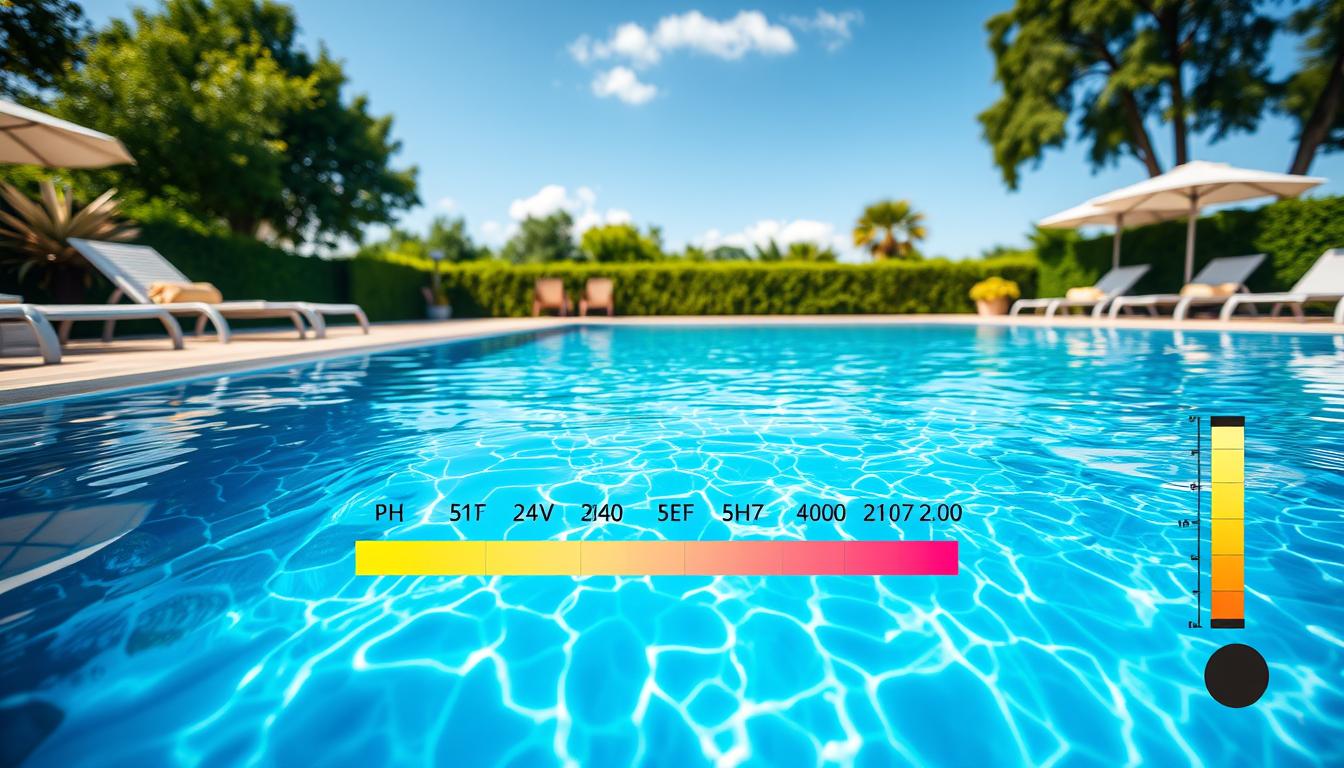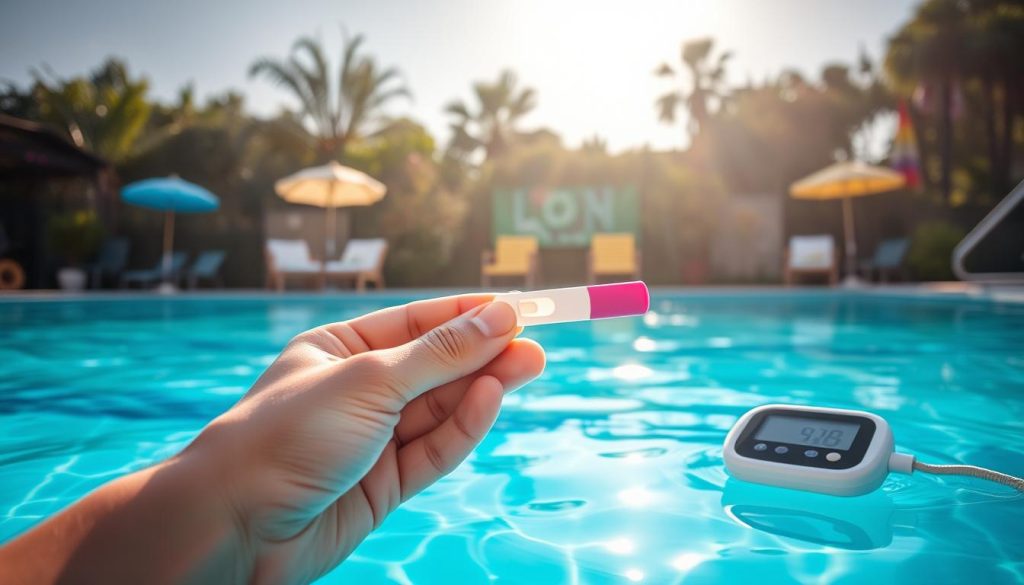
Summer’s here, and we’re ready to jump into our backyard pools. But first, we must check if the chlorine levels are safe. Too much chlorine can be harmful and ruin our swim.
Picture this: You’re hosting a pool party. You test the water and find sky-high chlorine levels. Your fun day is now on hold while you fix the problem.
Good pool chemistry keeps swimmers safe and healthy. Chlorine cleans the water, but balance is key. Safe chlorine levels range from 1.0 to 3.0 parts per million (ppm). Levels above 5 ppm are dangerous and need quick action.
This guide will explore chlorine levels in swimming pools. We’ll look at the risks of too much chlorine and what causes high levels. You’ll learn how to keep your pool safe all summer long.
Regular water testing and good pool care can prevent chlorine toxicity. These practices ensure your pool stays a healthy, fun place for everyone.
Understanding Chlorine Levels in Swimming Pools
Proper chlorine levels are vital for safe swimming. Pool owners must know the ideal chlorine range and risks of high levels. Regular monitoring helps prevent health hazards and protects pool equipment.
Ideal Chlorine Range for Safe Swimming
The best chlorine level for pools is 1 to 3 parts per million (ppm). This amount kills harmful bacteria and keeps water clean. Maintaining this range ensures a safe swim for everyone.
| Parameter | Ideal Range |
|---|---|
| Chlorine | 1-3 ppm |
| pH | 7.2-7.6 |
| Alkalinity | 80-120 ppm |
Dangers of Excessive Chlorine Levels
Too much chlorine can harm swimmers. Levels above 3 ppm may irritate eyes, skin, and lungs. High chlorine exposure can even cause poisoning.
Severe symptoms include burning eyes and throat, breathing problems, and nausea. Excess chlorine also damages pool equipment and surfaces.
- Burning sensation in the eyes, nose, and throat
- Difficulty breathing and chest tightness
- Nausea and vomiting
- Headaches and dizziness
Factors Contributing to High Chlorine Levels
Several things can raise chlorine levels in pools. These include wrong dosing, poor volume calculations, and lack of sunlight.
- Improper dosing or overuse of chlorine products
- Inaccurate pool volume calculations
- Insufficient sunlight exposure, which can slow down chlorine dissipation
- Low bather load, leading to reduced chlorine demand
- Imbalanced pH levels, affecting chlorine effectiveness
As responsible pool owners, we must stay vigilant and proactively monitor chlorine levels to maintain a safe and enjoyable swimming environment for everyone.
Knowing the right chlorine range is key to pool safety. Watch for high levels and their causes. This helps keep your pool balanced and healthy for all swimmers.
Symptoms of Chlorine Poisoning from Pool Water
Chlorine poisoning from pool water can cause various symptoms. It may affect your breathing, eyes, skin, and overall well-being. Knowing these signs helps you get help quickly if needed.
Respiratory Distress and Irritation
Breathing in too much chlorine can hurt your lungs. You might cough, wheeze, or feel short of breath. Your throat and chest may burn.
Indoor pools with poor air flow are risky. Chlorine gas can build up there. If you have these symptoms, go outside for fresh air.
See a doctor if the problems don’t go away.
Eye and Skin Irritation
High chlorine levels can irritate your eyes and skin. Your eyes may turn red, itch, and water. Your skin might become red, dry, and itchy.
Some people get “pool water dermatitis,” a type of skin allergy. After swimming, rinse your eyes and skin with clean water for 15 minutes.
If irritation continues or gets worse, talk to a doctor.
“Frequent swimmers, especially competitive swimmers and divers who spend more than six hours a week in chlorinated pools, are at a higher risk of developing chlorine-related side effects like eye irritation, skin issues, and even yellow teeth due to swimmer’s calculus.”
Headaches and Fatigue
Chlorine poisoning can cause headaches and make you feel tired. This happens more in indoor pools with strong chemical smells. If you get headaches or feel tired after swimming, take a break.
Make sure you swim in a well-kept pool with good air flow.
| Symptom | Explanation |
|---|---|
| Respiratory Distress | Coughing, wheezing, shortness of breath, and burning sensation in the throat and chest due to inhalation of chlorine gas or chloramines. |
| Eye Irritation | Red, itchy, and watery eyes caused by exposure to high chlorine levels in pool water. |
| Skin Irritation | Redness, dryness, itching, and irritation of the skin, with some individuals more prone to developing allergic contact dermatitis or “pool water dermatitis.” |
| Headaches | Persistent headaches may occur, particularly in indoor pools with high levels of chloramines and inadequate ventilation. |
| Fatigue | Exposure to excessive chlorine levels and strong chemical smells in poorly maintained pools can lead to feelings of fatigue and weakness. |
If you think you have chlorine poisoning, leave the pool area right away. Rinse your eyes and skin with clean water. See a doctor if symptoms don’t improve.
Stay aware of chlorine exposure risks. This helps you enjoy swimming safely.
What Chlorine Level is Too High to Swim
Testing pool water chlorine levels is vital for safe swimming. High chlorine levels can be dangerous. It’s crucial to know safe ranges and when levels are too high.
Pool testing kits help determine chlorine levels in water. These kits use color-changing reagents to measure chlorine concentration.
To test, collect water from 12-18 inches below the surface. Add the reagent, shake, and compare the color to the chart.

Testing Pool Water for Chlorine Levels
Measuring both free and combined chlorine is important. Free chlorine actively eliminates harmful microbes and neutralizes contaminants. It’s measured in parts per million (ppm).
Combined chlorine forms when free chlorine binds to contaminants. Levels below 0.2 ppm are ideal, while under 0.5 ppm is considered safe.
- Free chlorine is the active form of chlorine that effectively eliminates harmful microbes and neutralizes contaminants. It is typically measured in parts per million (ppm).
- Combined chlorine develops when free chlorine binds to contaminants during the sanitization process. Ideally, combined chlorine levels should be below 0.2 ppm and considered safe below 0.5 ppm.
Safe Chlorine Limits for Swimming
Safe chlorine levels for pool water have specific ranges. The table below shows ideal and safe ranges for free and combined chlorine.
| Chlorine Type | Ideal Range (ppm) | Safe Range (ppm) |
|---|---|---|
| Free Chlorine | 2.0 – 4.0 | 1.0 – 6.0 |
| Combined Chlorine | < 0.2 | < 0.5 |
For best swimming conditions, keep free chlorine between 1 and 3 ppm. The target is 3 ppm. Levels above 5 ppm are too high and need immediate action.
Actions to Take When Chlorine Levels Are Too High
If chlorine levels are too high, take these steps to reduce concentration:
- Stop adding chlorine to the pool until the levels decrease naturally.
- Expose the pool water to sunlight for 2-3 hours, as UV rays help break down chlorine.
- Add neutralizing chemicals such as sodium thiosulfate or sodium sulfite to lower chlorine levels rapidly.
- Partially drain and refill the pool with fresh water to dilute the chlorine concentration.
Regular monitoring of chlorine levels ensures safe swimming. Proper chlorine levels prevent risks associated with high concentrations in pool water.
Lowering High Chlorine Levels in Your Pool
Don’t worry if your pool’s chlorine levels are too high. There are several methods to bring them back to a safe range. First, stop adding chlorine to the pool. Turn off your chlorinator or remove chlorine tablets from the skimmer.
Allow your pool water to be exposed to sunlight for a few hours. This helps chlorine naturally dissipate, reducing levels over 3-5 days. For a quicker fix, use a chlorine remover chemical.
Follow instructions carefully when using these products. Add them gradually to avoid disrupting your pool’s chemistry. In some cases, you may need to partially drain and refill your pool.
To prevent high chlorine levels, consider an automatic sanitizing system. It adjusts chlorine output based on your pool’s needs. Regular testing with Water TechniX 7 in 1 Test Strips helps monitor chlorine levels.
Catch imbalances early by staying on top of pool maintenance. Focus on prevention rather than correction. With the right tools, balancing pool chemistry becomes much easier.







